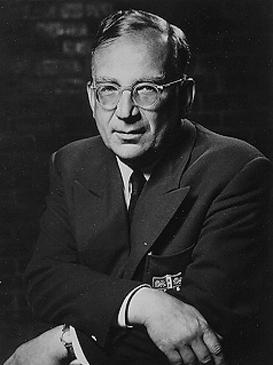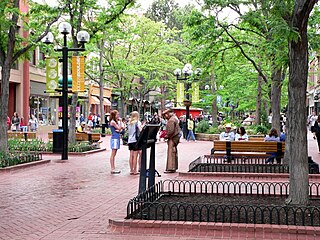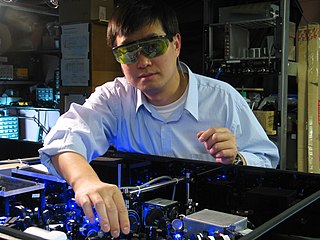Related Research Articles

George Gamow, born Georgiy Antonovich Gamov, was a Russian-born Soviet and American polymath, theoretical physicist and cosmologist. He was an early advocate and developer of Lemaître's Big Bang theory. He discovered a theoretical explanation of alpha decay by quantum tunneling, invented the liquid drop model and the first mathematical model of the atomic nucleus, and worked on radioactive decay, star formation, stellar nucleosynthesis and Big Bang nucleosynthesis, and molecular genetics.

Boulder is a home rule city that is the county seat and most populous municipality of Boulder County, Colorado, United States. The city population was 108,250 at the 2020 United States Census, making it the 12th most populous city in Colorado. Boulder is the principal city of the Boulder, CO Metropolitan Statistical Area and an important part of the Front Range Urban Corridor.

Carl Edwin Wieman is an American physicist and educationist at Stanford University, and currently the A.D White Professor at Large at Cornell University. In 1995, while at the University of Colorado Boulder, he and Eric Allin Cornell produced the first true Bose–Einstein condensate (BEC) and, in 2001, they and Wolfgang Ketterle were awarded the Nobel Prize in Physics. Wieman currently holds a joint appointment as Professor of Physics and Professor in the Stanford Graduate School of Education, as well as the DRC Professor in the Stanford University School of Engineering. In 2020, Wieman was awarded the Yidan Prize in Education Research for "his contribution in developing new techniques and tools in STEM education." citation.

The University of Colorado Boulder is a public research university in Boulder, Colorado. Founded in 1876, five months before Colorado became a state, it is the flagship university of the University of Colorado system. CU Boulder is a member of the Association of American Universities, a selective group of major research universities in North America, and is classified among R1: Doctoral Universities – Very high research activity. In 2021, the university attracted support of over $634 million for research and spent $536 million on research and development according to the National Science Foundation, ranking it 50th in the nation.

Eric Allin Cornell is an American physicist who, along with Carl E. Wieman, was able to synthesize the first Bose–Einstein condensate in 1995. For their efforts, Cornell, Wieman, and Wolfgang Ketterle shared the Nobel Prize in Physics in 2001.

Albert Allen Bartlett was an emeritus professor of physics at the University of Colorado at Boulder, US. As of July 2001 Professor Bartlett had lectured over 1,742 times since September, 1969 on Arithmetic, Population, and Energy. Bartlett regarded the word combination "sustainable growth" as an oxymoron, and argued that modest annual percentage population increases could lead to exponential growth. He therefore regarded human overpopulation as "The Greatest Challenge" facing humanity.
Brian Leeds DeMarco is a physicist and Professor of Physics at the University of Illinois at Urbana-Champaign. In 2005 he placed first in the quantum physics portion of the "Amazing Light" competition honoring Charles Townes, winner of the 1964 Nobel Prize in Physics. DeMarco is currently conducting experiments in quantum simulation.

William Duane was an American physicist who conducted research on radioactivity and X-rays and their usage in the treatment of cancer. He developed the Duane-Hunt Law and Duane's hypothesis. He worked with Pierre and Marie Curie in their University of Paris laboratory for six years and developed a method for generating quantities of radon-222 "seeds" from radium for usage in early forms of brachytherapy.

David Jeffrey Wineland is an American Nobel-laureate physicist at the National Institute of Standards and Technology (NIST) physics laboratory. His work has included advances in optics, specifically laser-cooling trapped ions and using ions for quantum-computing operations. He was awarded the 2012 Nobel Prize in Physics, jointly with Serge Haroche, for "ground-breaking experimental methods that enable measuring and manipulation of individual quantum systems".

An atomic clock is a clock that measures time by monitoring the resonant frequency of atoms. It is based on atoms having different energy levels. Electron states in an atom are associated with different energy levels, and in transitions between such states they interact with a very specific frequency of electromagnetic radiation. This phenomenon serves as the basis for the International System of Units' (SI) definition of a second:
The second, symbol s, is the SI unit of time. It is defined by taking the fixed numerical value of the caesium frequency, , the unperturbed ground-state hyperfine transition frequency of the caesium 133 atom, to be 9192631770 when expressed in the unit Hz, which is equal to s−1.
A quantum clock is a type of atomic clock with laser cooled single ions confined together in an electromagnetic ion trap. Developed in 2010 by physicists as the U.S. National Institute of Standards and Technology, the clock was 37 times more precise than the then-existing international standard. The quantum logic clock is based on an aluminium spectroscopy ion with a logic atom.

Ana Maria Rey is a Colombian theoretical physicist, professor at University of Colorado at Boulder, a JILA fellow, a fellow at National Institute of Standards and Technology and a fellow of the American Physical Society. Rey was the first Hispanic woman to win the Blavatnik Awards for Young Scientists in 2019.

David Wayne Allan is an American atomic clock physicist and author of the Allan variance, also known as the two-sample variance, a measure of frequency stability in clocks, oscillators and other applications. He worked for the National Bureau of Standards in Colorado.

Jun Ye is a Chinese-American physicist at JILA, National Institute of Standards and Technology, and the University of Colorado Boulder, working primarily in the field of atomic, molecular and optical physics.

Steven Cundiff is an American experimental physicist and the Harrison M. Randall collegiate professor of physics at the University of Michigan. His research interests include the production and manipulation of ultrafast pulses, in particular for applications in studying light-matter interactions. Cundiff is a Fellow of American Physical Society, the Optical Society of America, and the Institute of Electrical and Electronics Engineers. He is the co-author of the standard reference for frequency combs titled Femtosecond Optical Frequency Comb: Principle, Operation and Applications.
Charles A. Lory (1872 –1969) was an American academic administrator.

Heather Lewandowski is a professor of physics at the University of Colorado Boulder. She looks to understand the quantum mechanical processes in making chemical bonds. She uses time-varying inhomogeneous electric fields to achieve supersonic cooling. She also studies how students learn experimental skills in instructional physics labs and help to improve student learning in these environments. She is a Fellow of the American Physical Society.
Cindy A. Regal is an American experimental physicist most noted for her work in quantum optics; atomic, molecular, and optical physics (AMO); and cavity optomechanics. Regal is an associate professor in the Department of Physics at the University of Colorado and JILA Fellow; and a Fellow of the American Physical Society (APS).
Chris H. Greene is an American physicist and the Albert Overhauser Distinguished Professor of Physics and Astronomy at Purdue University. He was elected a member of the National Academy of Sciences in 2019.

Elizabeth Ann Donley is an American physicist. She is a researcher in the time and frequency division at the Physical Measurement Laboratory. Donley's research areas include the operation and development of atomic fountain clocks and chip scale atomic devices and instruments.
References
- ↑ "Scott Diddams". Physics. 2016-04-05. Retrieved 2018-04-05.
- ↑ Ball, Philip (13 July 2001). "Physicists better their time". Nature . Retrieved 5 April 2011.
- ↑ "'Comb on a chip' powers new atomic clock design" . Retrieved 2018-04-05.